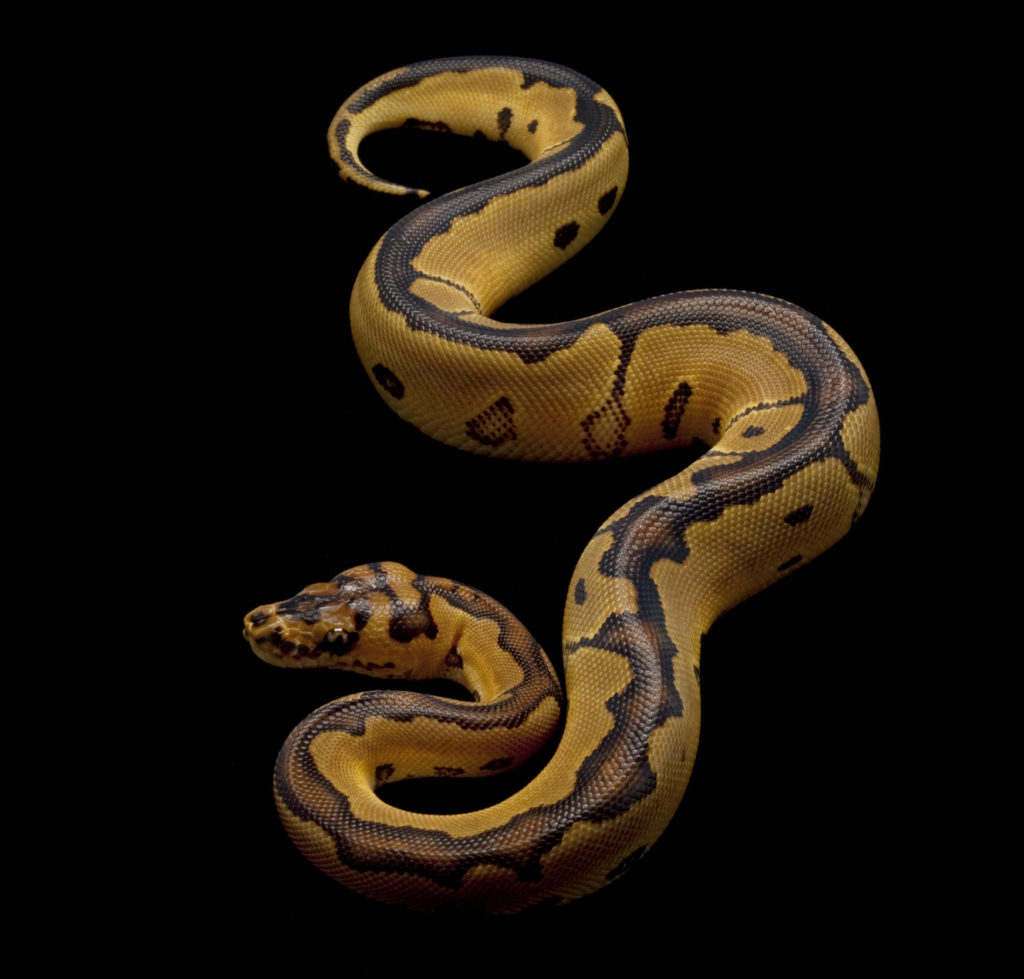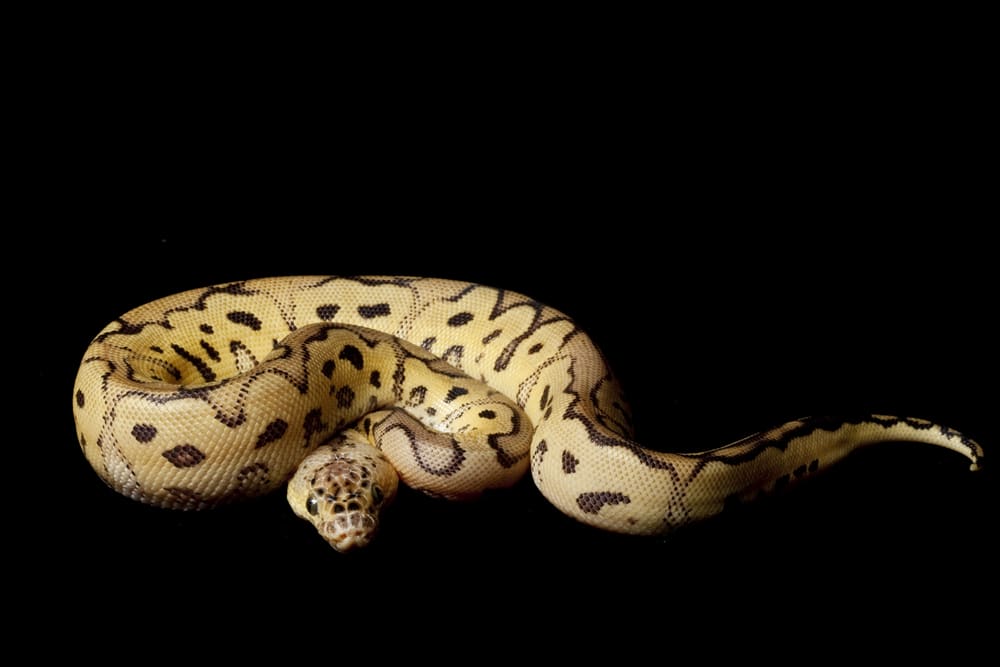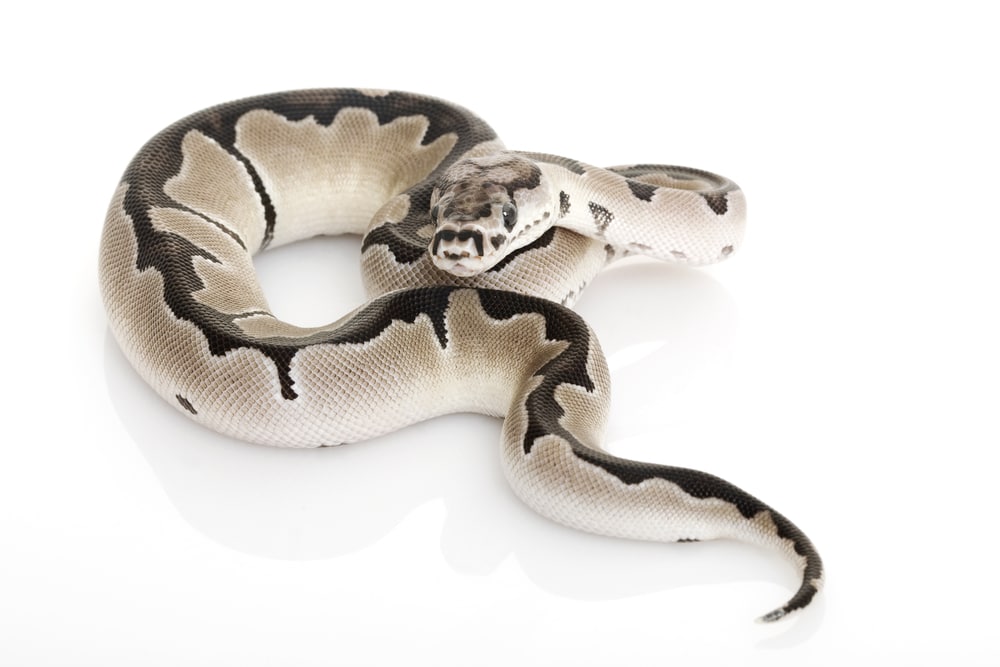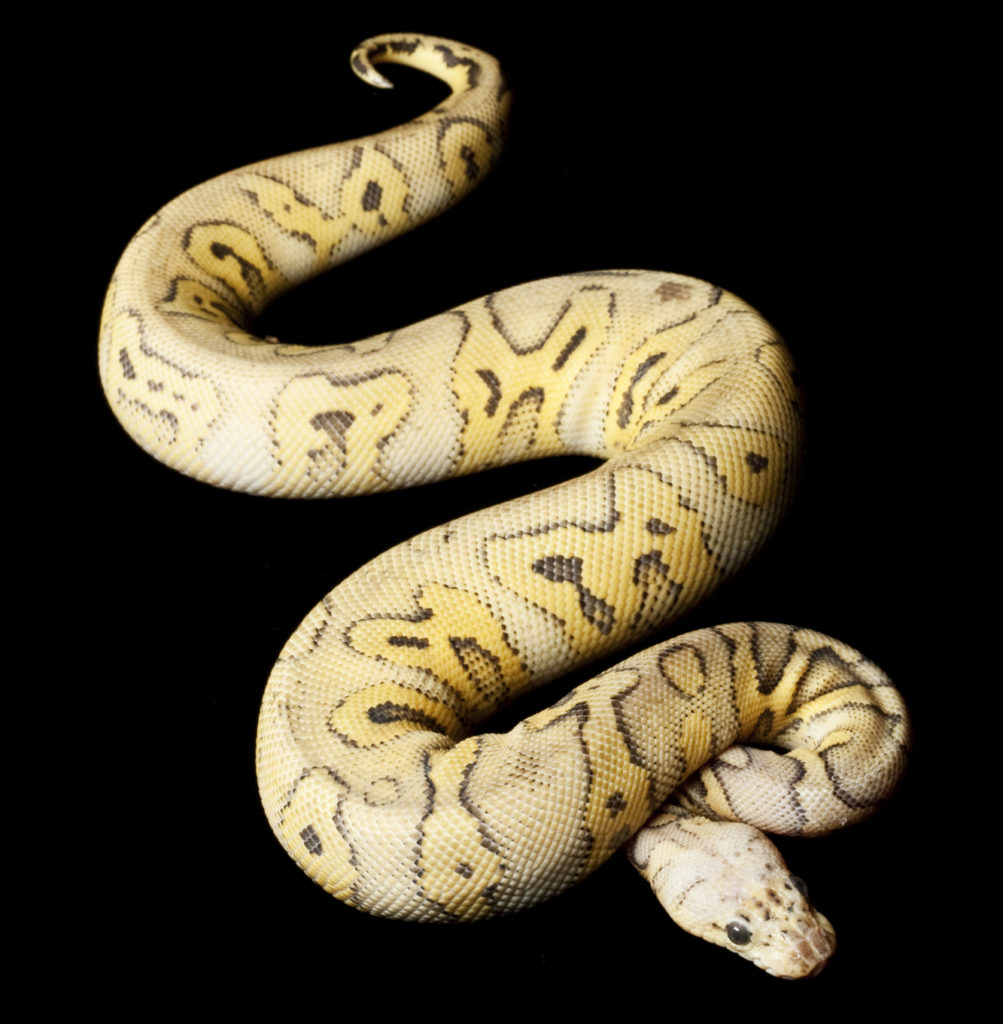In 1996 Dave and Tracy Barker of VPI acquired an attention-grabbing male ball python from Africa.
The new child ball had an unusually mottled head pattern, an odd physique pattern and a pale yellowish-gold background with not one of many typical ball python stippling. One spot beneath his eye reminded them of a harlequin’s tear, and so they additionally known as him a Clown ball.

In 1997 VPI acquired 1.2 African hatchlings which moreover confirmed these coloration and pattern anomalies. In 1998 the Barkers bred the first youngster to common females and produced clutches of normal-looking balls. This proved that the Clown pattern was not co-dominant identical to the Pastels. Nevertheless was Clown a heritable trait, or an aberration which could not be handed proper all the way down to the next know-how?
A 1999 breeding of the 1997 Clowns produced Clown offspring. In 2000 the 1996 Clown was bred with the 1997 Clowns and produced nonetheless additional Clowns. One different snake breeder, Brian Barczyk of BHB Reptiles, owned a wild-caught female who appeared to have the Clown mutation. When bred to a VPI Clown male in 2001, Barczyk’s female produced Clown offspring. The Barkers had a confirmed recessive morph on their arms – and a stunning one!
Extreme breeders rushed to VPI’s door to purchase their very personal Clowns and het Clowns. Giant names like NERD and The Snake Keeper (TSK) purchased het Clowns and inside a know-how or two had their very personal regular of Clown breeders. Their funding paid off, as Clown balls turned one of many essential sought-after morphs on the then-hot ball python morph market.
The price of Clowns has dropped considerably since their introduction. A Clown that may have value you $6,000 or additional in 2005 can as we converse be had for beneath $300. Nevertheless Clown balls are nonetheless strikingly beautiful snakes which solely get additional partaking as they mature. In case you want to add a ball python morph to your assortment, it’s possible you’ll’t go flawed with a Clown.
This article is going to inform you additional regarding the Clown ball python morph. It ought to make clear the genetics of piebaldism and can help you understand why your Clown ball has such beautiful coloration and patterns. It ought to moreover discuss just a few of the designer Clown morphs which might be discovered. Armed with that information it’s possible you’ll decide how Clowns match into your assortment as pets or breeders.
Clown Ball Python Morph Look
Clown ball pythons have little or no lateral darkish pattern. In its place of saddles they’ve splotchy darker patches. Their sides have a golden hue, and they also have a pronounced blotchy, broad dorsal stripe. There’s no mistaking a Clown for the standard ball python – or for each different morph!

Most ball pythons develop into darker with age. As Clowns mature, their coloration grows an increasing number of pale. By maturity their darkish pattern turns right into a pale yellowish brown in direction of a darkish tan background. The older they get, the additional partaking Clowns develop into!
Patterns differ between completely completely different Clowns. Some have fairly just a few blotches working from their dorsal stripe down their flanks. Others have largely clear flanks with just some slender markings that appear like dripping paint. All have a giant dorsal stripe with irregular edges.
Except for their unusual look, Clowns are sometimes no additional liable to points than common ball pythons. A healthful youngster Clown purchased from ball python breeder and raised in an accurate setting shouldn’t have any points thriving or producing healthful offspring.

Genetics
In vertebrates the melanocortin receptor (Mc1R) produces a darkish brown to black pigment known as eumelanin. Proteins produced by the agouti signaling protein gene (ASIP) act as an antagonist to the Mc1R receptor.
If the Agouti protein binds to the Mc1R gene, it blocks the alpha-Melanocyte Stimulating Hormone (α-MSH). In its place of producing eumelanin, the Mc1R produces a yellow-red pigment known as pheomelanin.
The Clown gene strongly reduces the manufacturing of melanin. Like Albinos, a Clown’s shed reveals no trace of the darkish pattern you uncover on a standard ball python’s shed. The dusting of black scales you uncover throughout the brown areas of a standard ball’s pores and pores and skin do not appear on a Clown.
As a ball python embryo develops throughout the egg, pigment cells begin migrating in direction of the pores and pores and skin. Pigment cells activated by α-MSH will produce eumalin, whereas these activated by the Agouti protein will produce pheomelanin.
The distribution of α-MSH and Agouti produce the ball’s pattern. Areas with additional eumelanin might be darkish brown or black, whereas these with additional pheomelanin might be lighter. The Clown gene produces a darker dorsal stripe and lighter sides.
Whereas the general pattern is predictable, the specifics of the distribution won’t be. Everyone knows {{that a}} Clown’s head might have mottling. We cannot inform whether or not or not or not they’re going to have teardrop markings identical to the Barkers’ first clown, nor inform whether or not or not they’re going to have additional or fewer patchy markings alongside their sides.
Pattern of Inheritance
The Clown gene is recessive. Every dad and mother ought to carry the gene and the zygote ought to acquire a reproduction from each. The offspring of a Clown ball python and a standard ball will all seem to be common ball pythons. Nevertheless each will carry one copy of the Clown mutation.
If one amongst these “het Clown” ball pythons mates with a Clown, half the clutch might be Clown and the alternative half het Clown. Nevertheless when two het Clown balls mate, points develop into additional tough. That clutch will embody:
- 25% Clown
- 50% Het Clown
- 25% Common
If a het Clown mates with a standard ball, half the clutch might be het Clown and half common balls. Breeders describe these clutches by the likelihood each normal-looking ball has of being het Clown.
- Clown + common: 100% het Clown
- 100% het Clown + 100% het Clown: 66% het Clown
- 100% het Clown + Clown: 50% het Clown
Some breeders declare het Clowns have brighter coloration than common balls. Others seek for white tail concepts or wider white strains throughout the darkish pattern. Nevertheless these won’t be reliable indicators. An ordinary-looking ball might later present het after it produces Clowns, and white tail concepts appear on some common balls. When shopping for het Clowns, a reliable breeder might be your best guarantee.

Clown Ball Python Factors
Clown ball pythons are no additional liable to genetic points than common ball pythons. On account of the Clown morph is incessantly blended with completely different morphs to create designer balls, it is best to confirm these morphs to see if they will end in neurological, skeletal or fertility points.
Normal Clown Ball Python Combos
Whereas the Clown morph could also be very partaking by itself, it really shines when blended with completely different morphs. Proper now it might be easier to find a “designer Clown” with two or additional morphs than an on a regular basis Clown. Among the many many hottest combos are:
Clown x Albino:The Clown’s blotchy pattern and broad dorsal stripe is especially hanging when blended with Albino coloration. The interplay of white and yellow appears to be like a lava lamp or an abstract painting.
Clown x Axanthic: An Axanthic Clown supplies you the Clown pattern in shades of gray. Axanthic Clowns will not darken as so much as widespread Axanthics. Sooner than breeding your Axanthic Clown, guarantee you’re working with the an identical breeder line.
Clown x Banana: A Banana Clown replaces the Clown’s golden-tan coloration with a wonderful yellow. The stripe and pattern are reproduced in pale lilac. And within the occasion you breed a Banana Clown to a Clown, half the offspring might be Banana Clowns.
Clown x Enchi: Like Clowns, Enchis improve with age. Enchi Clowns have brighter colors, fewer flank patterns and a additional sharply outlined dorsal stripe, albeit one which might be broken in a lot of places.
Clown x Fire: The Fire gene produces a lighter ball with a golden hue. Fire Clowns are additional golden. In a Fire Clown x Pastel Clown breeding, 25% of the offspring might be beautiful vibrant yellow Fire Pastel Clowns, or Firefly Clowns.
Clown x Mojave: A Mojave Clown’s flank patterns are lighter, with areas of near-white that appear like they’ve been airbrushed. Breeding two Mojave Clowns collectively will offer you 25% Super Mojave Clowns, a blue-eyed leucistic white snake that will produce 100% Mojave Clowns if bred to a Clown.
Clown x Pastel: The Pastel morph moreover reduces eumelanin manufacturing. The Clown Pastel is among the many most spectacular Pastel combos, with brighter tans and paler patterns. Breed two Clown Pastels collectively and 25% of your clutch might be spectacular Super Pastel Clowns.
Clown x Piebald: Harlequins traditionally wore “Pied” garments with patches of white. Combine the Clown’s jolly pattern with Piebald patches and you have a harlequin you acquired’t rapidly overlook!
Clowns have been used to create some fantastic triple and quadruple combos, along with:

Caring For a Clown Ball Python
Clown ball pythons are no tougher to spice up than a standard ball python. Give them sufficient home, a cosy hiding place, up to date water and a temperature gradient between 75° and 95°. Misting your Piebald’s container with a light-weight spray of water every couple of days will help assure clear and full sheds.
It is best to feed Clown balls, and ball pythons often, with frozen/thawed meals pretty than reside prey. A cornered rat can injure and even kill a snake. If in case you’ve got a fussy ball which turns up its snout at frozen meals, it is best to stun or kill the prey sooner than feeding. You can also try scenting thawed rats with rooster broth sooner than feeding.
Many fussy ball pythons are actually refusing meals because of stress. In case your Clown is refusing to eat, give them some quiet time. A towel over their cage can current privateness and smaller prey devices might present additional fascinating than greater ones. And in case your Clown’s stress is making you pressured, remember that snakes sometimes go months with out meals throughout the wild.
In case you occur to can see your fasting snake’s spine or if it loses dramatic portions of weight, it is best to take it to a veterinarian. In every other case, there’s no should be concerned. Your Clown will eat when it is ready to eat.
Conclusion
Clown ball pythons are beautiful, simple to keep up and relatively low-cost. Take your time to find a revered provider. The extra money you spend looking for a snake from in all probability the best breeders might stop heartache, time and veterinary funds in the end.
There are numerous boards for ball python lovers. The Kingsnaokaye Ball Python Dialogue board, BP Boards and Fauna Classifieds Ball Pythons Dialogue board have expert breeders and expert newbie householders who might be comfy to answer your questions.
Do you’ve got gotten a Clown ball python? What suggestion would you give any individual fascinated about together with a Clown to their assortment? Do you’ve got gotten any questions we haven’t answered? Share your tales, concepts and images throughout the suggestions beneath!











Leave a Reply